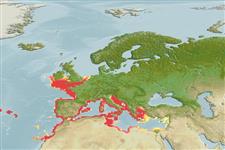Common names from other countries
Environment: milieu / climate zone / depth range / distribution range
Οικολογία
; εύρος βάθους 10 - 180 m (Ref. 113223). Subtropical, preferred 9°C (Ref. 107945); 53°N - 27°N, 32°W - 36°E (Ref. 114316)
Eastern Atlantic and the Mediterranean.
Length at first maturity / Μέγεθος / Βάρος / Age
Maturity: Lm ? range ? - ? cm Max length : 11.0 cm SHL αρσενικό/απροσδιόριστο; (Ref. 109255); μεγ. αναφερόμενη ηλικία: 40 έτη (Ref. 8702)
An active suspension feeder (Ref. 96376). Infaunal, found on sandy substrates (Ref. 113223).
Life cycle and mating behavior
Γεννητική Ωρίμανση | Αναπαραγωγή | Γεννοβολία | Αβγά | Γονιμότητα | Προνύμφες
Members of the class Bivalvia are mostly gonochoric, some are protandric hermaphrodites. Life cycle: Embryos develop into free-swimming trocophore larvae, succeeded by the bivalve veliger, resembling a miniature clam.
Gaspar, M.B., M.N. Santos, P. Vasconcelos and C.C. Monteiro. 2002. (Ref. 2736)
IUCN Red List Status (Ref. 130435)
CITES status (Ref. 108899)
Not Evaluated
Not Evaluated
Human uses
αλιεία: Εμπορικό(ά)
FAO - αλιεία: landings | FishSource | Η θάλασσα γύρω μας
Εργαλεία
Διαδικτυακές πηγές
Estimates based on models
Preferred temperature
(Ref.
115969): 10.8 - 21.5, mean 18.7 (based on 822 cells).
Ελαστικότητα
Μεσαίο(α), ελάχιστος χρόνος για διπλασιασμό πληθυσμού 1,4 - 4,4 έτη (K=0.21-0.38; tmax=40).
Vulnerability
Low vulnerability (10 of 100).
